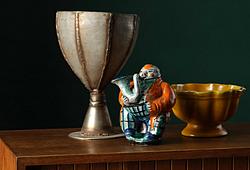A Wucai Transitional vase with cover, 17th Century, Shunzhi (1644-1661).
This vase is of ovoid form and brightly decorated in red, green, yellow and blue with quatrefoil panels reserved against a trefoil ground - of iron-red – each containing a fish swimming amongst aquatic weeds and flowers. The short neck is decorated with stylised waves interspersed with Daoist symbols. The cover is matched. Height with lid 36.2 cm
Slitage.
Provenance
Purchased from Bonhams Bond Street, London, November 2008, Lot 3.
The Avalon Collection.
This collection, which in the main focuses on the Interregnum and Kangxi periods has been both carefully and sensitively formed over the last twenty-five years. The collector, a member of the English Oriental Ceramic Society, has assembled the collection with an eye for provenance whilst purchasing from old European collections, well-established antique dealers and at auction.
Academically, the pieces have been well researched both in terms of their symbolism and narrative themes. In many instances the imagery on the pieces has been referenced to episodes in the romantic and historic novels of Chinese mythology, which were used extensively in the decoration of seventeenth century Chinese porcelain.
Literature
For a cup and saucer incorporating a design of different types of fish in Famille Verte see: Chinese Porcelain in Green Enamels”, by Christiaan J A Jorg, Page 141, Tem No 134.
More information
Each roundel is outlined in iron-red, green, yellow and blue and contains a single type of fish – carp, goldfish, catfish and mudfish. In contrast with its philosophical symbolism, fish have a more popular meaning based on the homophonous relationship that “fish” (yu) share with “surplus, abundant”. With the scale covered carp - identifiable here by its wide mouth, barbels attached to its upper lip and long dorsal fin – its name is homophonous with li meaning “power, strength and ability”.
Four freshwater fish together – as represented here on the body of the vase – represent qingbai lianjie or be “spotless and incorruptible”.




















































